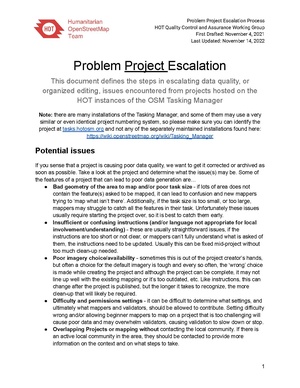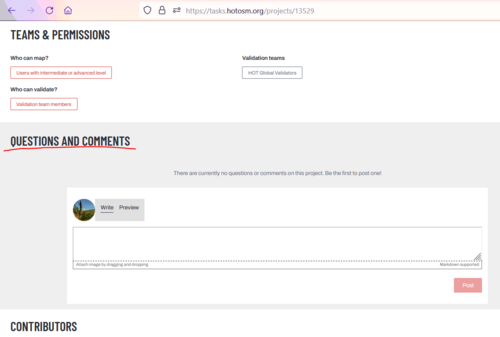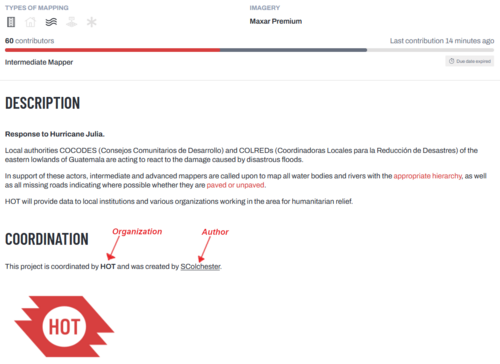Humanitarian OSM Team/Working groups/Data Quality Control and Assurance/Problem Project Escalation
Problem Project Escalation
This document defines the steps in escalating data quality, or organized editing, issues encountered from projects hosted on the HOT instances of the OSM Tasking Manager
Note: there are many installations of the Tasking Manager, and some of them may use a very similar or even identical project numbering system, so please make sure you can identify the project at tasks.hotosm.org and not any of the separately maintained installations found here: Tasking Manager
Potential issues
If you sense that a project is causing poor data quality, we want to get it corrected or archived as soon as possible. Take a look at the project and determine what the issue(s) may be. Some of the features of a project that can lead to poor data generation are…
- Bad geometry of the area to map and/or poor task size - if lots of area does not contain the feature(s) asked to be mapped, it can lead to confusion and new mappers trying to ‘map what isn’t there’. Additionally, if the task size is too small, or too large, mappers may struggle to catch all the features in their task. Unfortunately these issues usually require starting the project over, so it is best to catch them early.
- Insufficient or confusing instructions (and/or language not appropriate for local involvement/understanding) - these are usually straightforward issues, if the instructions are too short or not clear, or mappers can’t fully understand what is asked of them, the instructions need to be updated. Usually this can be fixed mid-project without too much clean-up needed.
- Poor imagery choice/availability - sometimes this is out of the project creator’s hands, but often a choice for the default imagery is tough and every so often, the ‘wrong’ choice is made while creating the project and although the project can be complete, it may not line up well with the existing mapping or it’s too outdated, etc. Like instructions, this can change after the project is published, but the longer it takes to recognize, the more clean-up that will likely be required.
- Difficulty and permissions settings - it can be challenging to determine what settings, and ultimately what mappers and validators, should be allowed to contribute. Setting difficulty wrong and/or allowing beginner mappers to map on a project that is too challenging will cause poor data and may overwhelm validators, causing validation to slow down or stop.
- Overlapping Projects or mapping without contacting the local community - If there is an active local community in the area, they should be contacted to provide more information on the context and on what steps to take.
- Lastly, you may find a project that is not in compliance with the Organised_Editing_Guidelines - HOT recognizes the importance of the OEG and asks that all Organizations using the Tasking Manager ensure that they are complying. However, we know that is not always the case and ask that you help us identify organizations that need a reminder.
Technical Note: when you find a suspect project - please use the URL of the project in communications with us (such as https://tasks.hotosm.org/projects/12345) sometimes the number (ie. project 12345) will work, but as mentioned before - other Tasking Manager installations may have an identical number.
Escalation Steps
Use these steps to escalate the issues to the appropriate person or group.
- Each project has a Question and Comments section...
- We encourage everyone to first put a message here, additionally you can notify either the project creator/author, or the project managers (if a Team has been assigned to manage the project) - use #author or #managers respectively.
- Example: “Hello #managers - I noticed this project allows anyone to validate, what are your plans for quality assurance?”
- Note: Comments are formatted with Markdown, so be careful not to add # or other special characters as the first thing in your comment or you may end up formatting the entire comment oddly, and end up not sending the notification as intended.
- We encourage everyone to first put a message here, additionally you can notify either the project creator/author, or the project managers (if a Team has been assigned to manage the project) - use #author or #managers respectively.
- If no one replies to your comment, or you prefer to contact them more discreetly, please reach out to the project author/owner directly…
- You will find the author/owner under Coordination, click their name and towards the top of their profile you will find at least a link to their OpenStreetMap profile but possibly many other ways to contact them.
- If you do not get a response from the project creator/owner, then you can also click on the organization link (also found under Coordination on the project page shown above) and/or the logo of the organization (if displayed, such as the HOT logo in the above example). That will take you to a page about the organization and the managers/admins for that organization. As above you can try contacting them (if different than the project creator) as that Organization is ultimately responsible for the management of the project in question.
- If at any step above, you are not comfortable, or are not sure; or all contact attempts have gone unanswered you may email dataquality @ hotosm.org and ask for assistance, or discuss in the #quality-control_wg channel in the HOT Slack. Note that this is a volunteer working group so requests may need to be addressed more slowly/after current priorities, so we encourage individuals and communities to initiate the steps above for quicker resolution.


